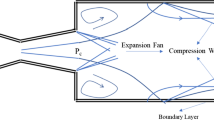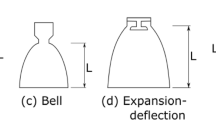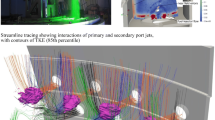Abstract
In this paper, simpler methods of measuring various performance parameters, such as pivot point excursions, actuation angles, and symmetry of the nozzle motion of a flex nozzle system (FNS) meant for a large solid rocket booster nozzle are reported. A novel attempt is made to estimate the above parameters using the pivot point co-ordinates as primary data. Towards this objective, the trajectories of a reference point obtained using one stereo based 3-dimensional Digital Image Correlation (3-D DIC) system, above a nozzle simulator during the vectoring tests, were utilized. A linear least squares (LLS) method is proposed and validated for locating the pivot point from the 3-D DIC trajectory. The pivot point location and the measured DIC displacements were further analyzed to evaluate the target parameters. The results show that use of the 3-D DIC system provides confidence on the performance of the actuators with a simplified measurement scheme. Moreover, it generates useful additional data, as spin-offs, comparable with the conventional measurements. Thereby data reduction, testing time and resource required for characterization of a FNS is expected to reduce considerably.










Similar content being viewed by others
Notes
The nozzle simulator is a dummy nozzle called as cross beam assembly. Henceforth, the names nozzle simulator, cross beam assembly and dummy nozzle will be used interchangeably in the text.
A larger area however cannot be chosen for averaging because of the tilting of the cross beam during actuation.
The line joining the pivot point to the reference point is the pivot radius; see Fig. 7 from the cut side.
References
Woodberry RFH (1975) Flexible joints for thrust vector controls, AIAA and SAE 11th Propulsion Conference, Anaheim, California AIAA-75-1221
Kobalter GF Flexible nozzle for a thrust vector control system, US Patent No - US3860134 A
Nagappa R, Kurup MR, Muthunayagam AE (1989) ISRO’S solid rocket motors. Acta Astronaut 19 (8):681–697
Report NASA (1974) Solid rocket thrust vector control NASA-SP-8114
Donat JR (1993) Solid rocket motor nozzle flexseal design sensitivity, AIAA, AHS, and ASEE, Aerospace Design Conference, Irvine, California AIAA-93-1122
Yongbin Z (2007) Discussion on control precision of single swing nozzle. Mod Def Technol 35(3):54–57
Sutton MA, Orteu JJ, Schrier HW (2009) Image correlation for shape, motion and deformation measurement. Springer, USA
Bornert M, Hild F, Orteu JJ, Roux S (2012) Digital Image Correlation. In: Grediac M, Hild F, Pineau A (Eds) Full-Field Measurements and Identification in Solid Mechanics. Wiley-ISTE, chapter 6, pp 157–190
Peters WH, Ranson WF (1982) Digital image techniques in experimental stress analysis. Opt Eng 21 (3):427–431
Peters WH, Ranson WF, Sutton MA, Chu TC, Anderson J (1983) Application Of Digital Correlation Methods To Rigid Body Mechanics. Opt Eng 22(6):226738
Kahn-Jetter ZL, Chu TC (1990) Three-dimensional displacement measurements using digital image correlation and photogrammetric analysis. Exp Mech 30(1):10–16
Luo PF, Chao YJ, Sutton MA, Peters WH (1993) Accurate measurement of three-dimensional deformations in deformable and rigid bodies using computer vision. Exp Mech 33(2):123– 132
Cardenas-Garcia JF, Yao HG, Zheng S (1995) 3D Reconstruction of objects using stereo imaging. Opt Lasers Eng 22(3):193–213
Helm JD, McNeill SR, Sutton MA (1996) Improved three-dimensional image correlation for surface displacement measurement. Opt Eng 35(7):1911–1920
Sutton MA, McNeill SR, Helm JD, Chao YJ (2000) Advances in two-dimensional and three-dimensional computer vision. In: Rastogi P K (ed) Photomechanics. Springer, Berlin Heidelberg, pp 323–372
Orteu JJ (2009) 3-D Computer vision in experimental mechanics. Opt Lasers Eng 47(34):282–291
Quan C, Tay C, Sun W, He X (2008) Determination of three-dimensional displacement using two-dimensional digital image correlation. Appl Opt 47(4):583–593
Xia S, Gdoutou A, Ravichandran G (2013) Diffraction assisted image correlation: a novel method for measuring three-dimensional deformation using two-dimensional digital image correlation. Exp Mech 53(5):755–765
Pan B, Yu LP, Zhang QB (2018) Review of single-camera stereo-digital image correlation techniques for full-field 3D shape and deformation measurement. Sci China Tech Sci 61(1):2–20
Li J, Dan X, Xu W, Wang Y, Yang G, Yang L (2017) 3D Digital image correlation using single color camera pseudo-stereo system. Opt Laser Technol 95:1–7
Li J, Zhang B, Kang X, Xu W, Yang G, Yang L (2018) Single camera 3D digital image correlation using a polarized system. Instrum Exp Tech 61(1):99–105
Zhong FQ, Shao XX, Quan C (2018) 3D digital image correlation using a single 3-CCD colour camera and dichroic filter. Measur Sci Technol 29(4):045401
Gaffin RD (1977) Space shuttle solid rocket booster nozzle flexible seal pivot point dynamics, AIAA/SAE 13th Propulsion Conference, Florida, AIAA-P-77–986
Yoo JS (2010) First Korea space launch vehicle kick motor movable nozzle motion. J Space Craft Rocket 47 (1):153–168
Zhang LF, Guo YB, Chen G, Ye D, Chen RS (2010) Estimation of nozzle axis and vector angle by infrared photoelectric measurement technology. J Harbin Inst Technol 42(1):24–28
Seely J, Torick R, Mascio W (1990) Nozzle vector angle determination using a laser measurement system, AIAA/SAE/ASME/ASEE 26th Joint Propulsion Conference, Orlando, Florida, AIM-90-2082
Zhang CF, Tang WY, Li HP, Wang J, Chen JC (2007) Application of laser tracker to thrust line measurement of solid rocket motor. J Solid Rocket Technol 30(6):548–551
Guo Y, Chen G, Ye D, Yu X, Yuan F (2013) 2-DOF angle measurement of rocket nozzle with multivision, Advanced Mechanical Engineering, Article ID 942580. Hindwai Publication, Cairo. https://doi.org/10.1155/2013/942580J
Qu Y, Yang H (2015) High-speed measurement of nozzle swing angle of rocket engine based on monocular vision, Ninth International Symposium on Precision Engineering Measurement and Instrumentation. Proc SPIE 9446 (1–9):944647
Guo Y, Ye D, Chen G, Yuan F (2012) Binocular vision-vased measurement for motion parameters of rocket nozzle. Appl Mech Mater 220–223:1056–1061
Wang X, Tan J, Zhao Q, Ling Q (2015) Computer vision-based swing center testing method for flexible joint, Seventh International Symposium on Precision Mechanical Measurements. Proc SPIE 9903(1–7):990320
VIC3D and VICSNAP The 3-D DIC commerical code and the image cpaturing software, Supplied by M/s Correlated Solutions, USA
Acknowledgements
The authors have great pleasure in acknowledging the support rendered by Mr. S Karthigai Selvan, Sr. Tech. Asst. and Mr S N Suresh, Sr. Technician, both from ETS/EXMD, VSSC for their support during test and data generation. The authors specially acknowledge Mr. V. Eswaran, Deputy Director, Solid Propulsion and Research (SPR) Entity (also Project Director, S200 Project), VSSC for his encouragement, internal review of the manuscript and valuable suggestions. The LVDT and other instrumentation support provided by Mr Dhrishit M P, PRG/SPR Entity, VSSC and his team during the vectoring test of S200 flex seals is also acknowledged.
Author information
Authors and Affiliations
Corresponding author
Rights and permissions
About this article
Cite this article
Swain, D., Biswal, S., Thomas, B. et al. Performance Characterization of a Flexible Nozzle System (FNS) of a Large Solid Rocket Booster Using 3-D DIC. Exp Tech 43, 429–443 (2019). https://doi.org/10.1007/s40799-018-0282-x
Received:
Accepted:
Published:
Issue Date:
DOI: https://doi.org/10.1007/s40799-018-0282-x




